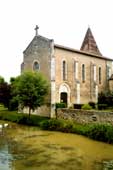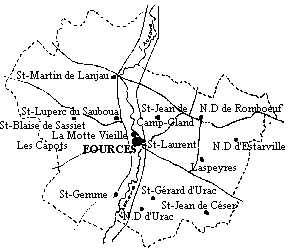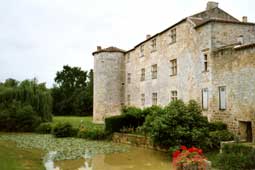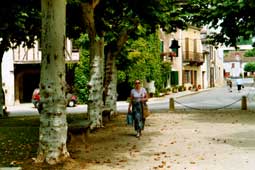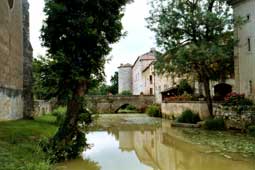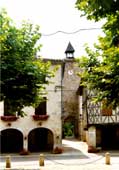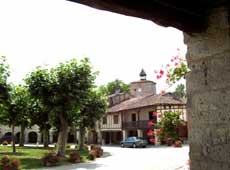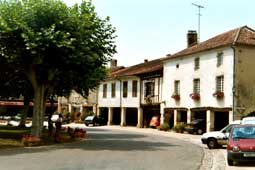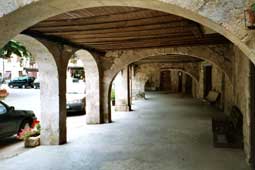 |
Patrick Delaforce & Ken Baldry'The Delaforce Family History' Chapter 28 - Fourcès |
Chapter 28
"The splendor falls on castle walls" Alfred, Lord Tennyson
Fourcès
|
Fourcès is staggeringly pretty, with its round bastide & with trees on the site of the original castle. It is partly surrounded by the River Auzoue, which moves so slowly that it is full of water lilies. However, this gentle stream is responsible for Fourcès being developed as a fortified site. It appears on a map of 1020 but the first indication in official records is from 1068, which certifies the existence of a fortified village & the second in 1086, when it is recorded that the Seigneur of Fourcès had the right to raise taxes,to form an army, to have a judiciary and to exert vassalage, but its fortunes declined and by the end of the century, the ruling family was involved in an abortive revolt against the powerful Duke of Aquitaine. Guillaume IX 'Le Troubadour', was duke from 1086 - 1127 & the grandfather of Eleanor of Aquitaine, Queen of France & then, England & allegedly, the most beautiful woman of all time. The revolt was presumably by one of the early Bernards, see chapter 40, trying to keep a purely nominal allegeance to France rather than have a more seriously imposed one to England. Duke Guillaume IX (22/10/1071 - 1127) was a poet & musician who wrote in the Occitan language. He appears to have picked up the style of Moorish singers & poets & introduced it to France. Some of his work is ribald & merry but some speaks of courtly love, at which he was better on paper than in practice, being divorced twice & the first time, excommunicated for having repudiated his wife, Ermengarde daughter of Foulques IV Comte d'Anjou in 1090, having only married her two years before. He married Philippa of Toulouse in 1094 & she lasted, or put up with him, until 1115, when they, too, divorced. Going back four generations, none of his forbears seem to be ours.
It seems that the bastide of Fourcès was built after this in about 1255 & is unique in Gascony in being circular, that is, a more modern circular castle was built in the middle, surrounded by a moat (now the road). This is now the wooded area. However, in the 1279 Treaty of Amiens, the village passed into the hands of the English King Edward I and the Seigneurs of Fourcès swore allegiance to him. This was to last through to the beginnings of the "Hundred Year's War" until when, in 1352 the village reverted to the French crown. At that time Guillaume and Jourdain de Fourcès were the local lords. While the castle seems to have been destroyed during the Saint-Sardos War (1323-1327, see the previous chapter) in 1325, it must have been rebuilt or repaired soon after. In 1378, Thomelin de Fourcès accompanied Constable Duguesclin on his Spanish campaign. The castle was destroyed again on May 13th 1488 by Charles VIII for unspecified crimes by the joint seigneur. It must have grown to be a formidable structure, judging by the resources devoted to dismantling it ("cinq à six cens hommes à pié, armatz de balestes, pes de crabe et aultres ferramens"). Presumably, since we know that Jean de la Force was one seigneur, the criminal was the other one, as both Jean and our ancestor Sir Bernard de la Force welcomed Charles VIII to Auch in 1491. However, justice was contingent in the 15th Century & any one act could lead either to forgiveness or beheading, depending on other considerations. Sir Bernard, who had been granted one third of the village, built the 'new' castle just outside the bastide in 1491, on the banks of the Auzoue. He retired to Fourcès the following year after a lifetime of diplomacy between the powers of Western Europe (see chapter 24). His son Bernard seems to have continued as the Lord of Fourcès but, since we are descended from his younger brother Anthony, we have no further information about Fourcès at this time, although the line of Bernards did continue for several hundred years The people of Fourcès are justifiably proud of their record in World War II for smuggling downed allied airmen into Spain but that is another story.
It will be apparent in the previous chapter, that the grand narrative has become rather shaky, as is only to be expected at this distance in time. However, it does continue & meanwhile, we must follow further the fortunes of detectable family members in these turbulent centuries. |
|
Contact: Ken Baldry at 17 Gerrard Road, Islington, London N1 8AY
+44(0)20 7359 6294 or e-mail him |

